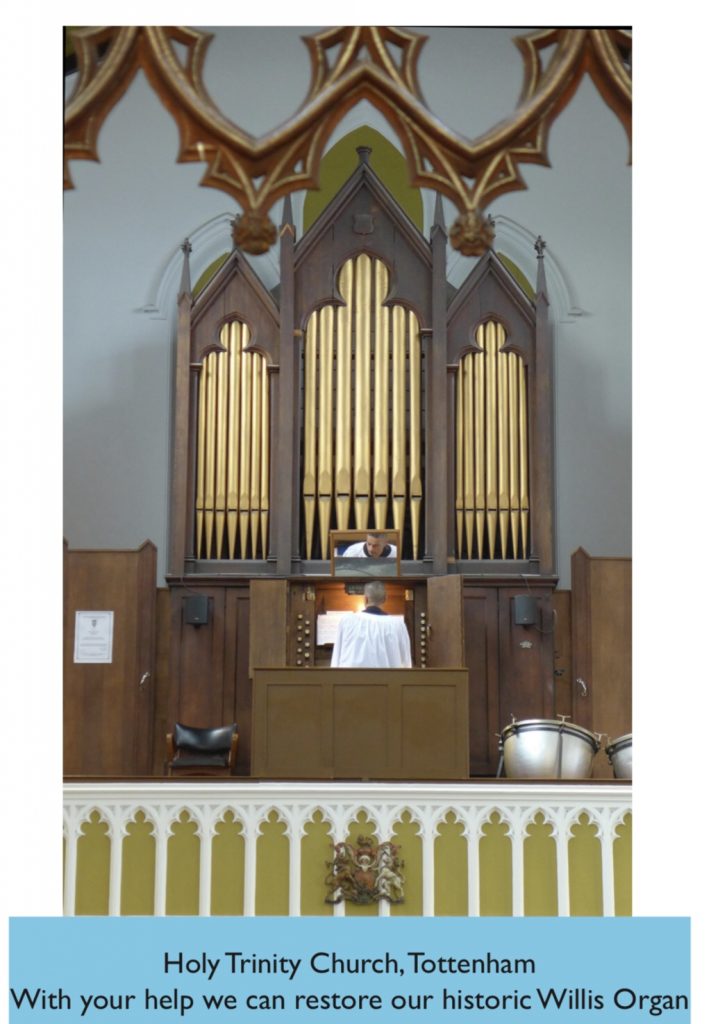Please help us to restore our historic Father Henry Willis Pipe Organ.
We have raised £30,000 by Parish Fund Raising over the past three years but more help is urgently needed. Over £130,000 is still required.
Our Father Henry Willis Pipe Organ
Built-in 1859, in a case by John Gray dating from 1838 Music is an inspirational part of our church life and worship. Our main weekly service, Parish Eucharist on Sundays, is led by the organ and our fully robed choir. This service becomes the Family Service and ‘Gospel Sunday’ on a regular pattern each month. The organ and choir play no less a part in these services but adopt different styles of music to reflect the nature of the service. The organ lifts our eyes to heaven; it inspires us to continue our pilgrim journey; it consoles us as we face our own mortality; it expresses our joy; it comforts us and gives us hope for a peaceful world. The organ speaks directly to our innermost soul. Beyond our usual worship services, we host the Civic Annual Remembrance Day service and a candlelit service of lessons and Christmas carols with cameos from the choir and organ.
We also host various community meetings and ecumenical gatherings. These include hustings at election time, social justice consultations and civic conferences. For example, we recently hosted key stakeholders involved in the planning and delivery of new Housing Schemes in Tottenham. This was attended by the Area Bishop – the Rt Rev’d Rob Wickham. Our organ is a fine early instrument by Henry Willis (Father Willis). It is said to be one of only two early Willis small organs still in working order. (The other is to be found at St Mildred’s Church, Whippingham, the Isle of Wight, installed on the instructions of Queen Victoria c1857 and enlarged by Willis in 1861. Osbourne House, a favourite home of Queen Victoria’s, is in the parish of St Mildred.) Our organ was built in 1859 but is housed in a case made by John Gray in 1838. In other words, our organ has been in continuous use for nearly 160 years. It is not surprising, therefore, that it requires a complete overhaul. Our organ is historically significant. By 1859 Willis was the ‘star’ organ builder in Britain, his fame founded on his organ for the Great Exhibition (1851) so admired by HM Queen Victoria and HRH Prince Albert. No 5 wonder Her Majesty commissioned Willis to build an organ for her parish church in 1857. It is astounding to realise that two years later a Willis two-manual organ was installed in our Church! Our forebears achieved their goal to get the foremost organ builder of their day to build the organ in their church. We have a duty to make sustain their achievement by restoring this remarkable instrument.
Historical Background
Henry Willis was unrivalled in his skill and genius in organ building. He was an accomplished organist. He understood the organ as an organist. Willis was painstaking in his approach to every detail of the instrument. He paid attention to every aspect of organ production. Small in stature he was renowned for his boundless energy. He was an inventor and an engineer. No wonder his organs have such a distinctive bright, lyrical sound. The Dictionary of National Biography’s (DNB) entry on Willis comments, “The rich and clearly focussed colours at every dynamic level of a Willis Organ reflected the insights he gained into nineteenth-century trends in orchestral instruments and orchestration.” He was an accomplished double-bass player. The DNB continues, “He had his very own systems of pipe scaling and voicing in both individual flute ranks and choruses, a distinctive accord of diverse tone colours with a balance of harmony and clarity of texture.”
Henry was born in North London on 27th April 1821, son of Henry Willis a local builder. (Henry Willis the organ builder is often referred to as Henry Willis 1.) In 1837, at the age of 14, Henry was articled to the company of John Gray & Son, the foremost organ builder in London at that time. He completed his seven-year apprenticeship in 1842. During this time he is said to have invented a manual-pedal coupler that he used throughout his career. Other inventions were to follow throughout his career. Willis’s biographer, W L Sumner, reminds us that until the beginning of the nineteenth century a three manual organ would have a properly developed light diapason chorus on the great organ, a smaller chorus in the choir organ and a short compass swell-organ with a few stops. As a rule, there were no pedals. Willis’s inventiveness and drive helped develop the organ as we know it today. He was particularly known for his use of the radiating pedalboards. After completing his apprenticeship Willis went to work for Wardle Eastland Evans, a violinist and ingenious instrument maker based in Cheltenham. Evans specialised in reed instruments of the harmonium type but he was also an organ builder and kept a music shop. Henry returned to London in 1845 and set up his own firm of organ builders. His first notable task was to rebuild the organ at Gloucester Cathedral in 1847. Willis was to go on to construct grand organs in many of the greatest cathedrals in our land including St Pauls, Durham, Edinburgh, Glasgow, Lincoln, Salisbury, Wells, and Winchester as well as the Royal Albert Hall, St George’s Hall, Liverpool, Blenheim Palace and Haringey’s very own Alexandra Palace. Later in life, Willis himself said that his work at Gloucester Cathedral was his “stepping stone to fame”. Not surprisingly other commissions in the West Country followed. During this time Willis met the Revd. Dr John Baron, Rector of Upton Scudamore, near Warminster. Baron thought that small churches needed small and simple pipe organs, rather than use a harmonium, the only practical alternative. Baron wrote a book on this theme. Willis made the construction of small organs a special branch of his company. Most of these ‘Scudamore organs’ only had three stops, open and stopped diapason with a principal and 18 coupled pedals and projected a mere 12 inches from the wall of the platform on which they stood. Our organ is not a ‘Scudamore organ’, it is larger in every respect (it fills Gray’s very large case) but it must have come from Willis’s small organ works at 119 Albany Street, Regents Park. 7 Sumner tells us that “Willis hardly ever left his name-plate on an organ of this early period, because he insisted that the tone of the organ revealed its maker, but some of his organs bore a brass plate engraved Henry Willis, in old English lettering.” Our organ has such a plate. Once back in London Willis became organist at Hampstead Parish Church and Islington Chapel of Ease. He had been the organist at Christ Church, Hoxton whilst serving his apprenticeship, a job he won by being able to play the ‘Hallelujah Chorus’ from Handel’s ‘Messiah’. ‘Messiah’ was a favourite of Willis. It is worth noting that Willis often gave the opening recital on his newly built organs or, failing that, played at the first service. Only three English organ builders have been affectionately called ‘Father’: John Howe (c1526 to c1571), Bernard Smith (1630-1708) and Henry Willis 1 (1821-1901).
On 12th June 2010 the organ of Holy Trinity Church Tottenham was awarded a certificate Grade II by the British Institute of Organ Studies. The organ is therefore listed in the Institute’s Register of Historic Pipe Organs as being “an instrument of importance to the national heritage and one deserving careful preservation for the benefit of future generations.”
Our Willis organ is a monument to the finest organ builder in the Victorian era. Its sound is its breath of life. Our Organist, Mr John Khwaja, is adept at getting the best out of the instrument (he has been playing this organ for 20 years). So too is our Assistant Organist, Mr. Joduni Okrafo-Smart. But there will come a time when the organ will fail, worn out by old age. We have had the organ serviced at regular intervals by Bishop & Son, organ builders. Because of its age, many notes are unplayable and stops unusable. Full restoration and rebuilding are required. Our predecessors bequeathed us the finest small organ of its day. We own it to our successors to leave them a similar legacy: our historic Willis organ in full voice.

